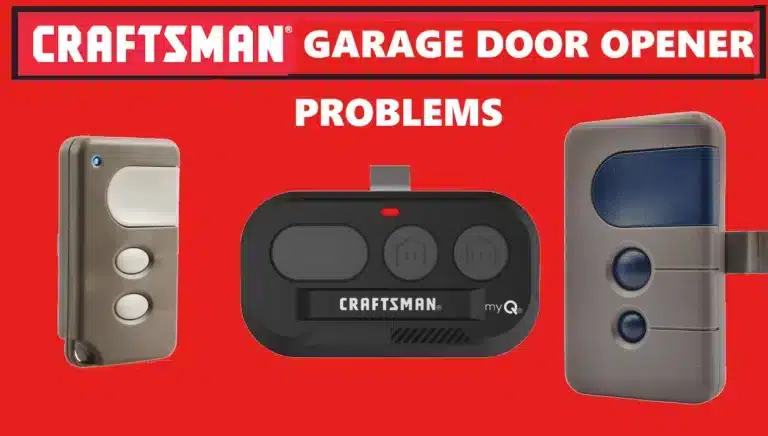A Craftsman garage door opener safety sensor being adjusted on the door track. All modern Craftsman garage door openers are equipped with safety sensors – those small black units mounted near the bottom of your garage door tracks. These sensors are crucial: they prevent the door from closing on a person, pet, or object in the doorway by detecting obstacles with an infrared beam. In this section, we’ll explain how Craftsman garage door sensors work, how to install or align them properly, common issues you might encounter, and tips for maintaining them. Consider this a friendly guide to everything about your garage door’s “electric eyes.”
How Do Craftsman Garage Door Sensors Work?
Craftsman (and all Chamberlain-made) sensors come as a pair:
- Sending Sensor: This unit emits an invisible infrared beam across the garage opening. It usually has a yellow or amber LED light that is steady on, indicating it’s powered and sending.
- Receiving Sensor: Placed directly opposite the sender, this one has a green LED light. It “looks for” the infrared beam from the sender. When it receives it steadily, the green light stays on, telling the opener that the path is clear.
If anything interrupts the beam (or if the sensors are misaligned), the green LED on the receiving sensor will go off or flicker. The opener interprets that as an obstruction. In practical terms, this means if you try to close the door under those conditions, the opener will reverse the door to open (or refuse to move it down at all). Conversely, as long as the green light is solid, the opener knows the path is clear to close the door.
These sensors are low-voltage devices, typically wired to the opener with two thin wires each. They sit about 4-6 inches off the ground, a few inches inside the door frame on each side. This low mounting catches objects like small children or pets that a higher sensor might miss.
Key safety note: The door will not close (via remote or normally) if the sensor beam is broken. You can however close the door by pressing and holding the wall button (constant pressure override) – the opener will force-close since you’re overriding the safety (only do this when you’ve checked that it’s safe, e.g., if a sensor is faulty). The system is designed so you should never intentionally bypass the sensors except in such manual override situations.
Installing or Replacing Craftsman Garage Door Sensors
When you set up a Craftsman opener (or if you need to replace the sensors), here’s what to do:
- Mount the Sensors: They come with L-shaped metal brackets. Attach each bracket to the lower track (there are usually pre-drilled holes or you can clamp it around the track). Mount the sending sensor on one side and the receiving on the other, facing each other. Position them about 4-6 inches above the floor (the manual often says “no higher than 6 inches”). Secure them with the provided hardware (carriage bolt and wing-nut through the bracket).
- Wire them to the Opener: Run the two conductor wires from each sensor up along the wall (staple neatly, without pinching the wire) back to the opener’s power head. Typically, connect the white wire from both sensors to the white terminal on the opener, and the white/black (or solid black) wires from both to the grey terminal. This puts them in a parallel circuit to the opener. Many Craftsman openers have clearly labeled terminals or color coding for this.
- Alignment: Before fully tightening, align the sensors. Because of how they work, they must be pointing directly at each other’s lenses. An easy method: Loosely mount them so they can move, then aim the sending unit straight across (measure from the floor or use a level to ensure both are at equal height). Then adjust the receiving sensor by slowly pivoting it until its green LED comes on solid. “Make sure the sending sensor’s amber light is on, then check the green light on the receiving sensor,” instructs Sears Home Services. When that green light is shining steadily, tighten the wing nuts to lock the sensors in that position. Now they’re aligned.
- Test the System: Activate the door (use the remote or wall control to close the door). If the sensors are aligned, the door should close normally. Now wave an object (like a broom) in front of the sensors while the door is closing – the door should immediately stop and reverse. Also, try closing the door with something actually in the way: place a garbage can or box in the doorway. The door shouldn’t even start down, and the opener lights should flash. This confirms the sensors properly detect obstructions.
During installation, if the sensors are not yet wired or aligned, the opener will not close the door (it will behave as if there’s an obstruction). So you have to get them set correctly to complete setup.
Common Craftsman Garage Door Sensor Issues and How to Fix Them
1. Sensor LED Lights Off or Flashing: Under normal operation, you’ll see one sensor light (amber) steady, and the other (green) steady. If amber is off on the sending unit, it might not have power – check the wiring connections at the opener, and ensure the wire isn’t cut. If green is off or flickering, it’s not seeing the beam – this could mean misalignment or a dirty lens. Try realigning as described above. Clean the sensor eyes with a soft cloth (no solvents, just wipe dust away). Also ensure direct sunlight isn’t hitting the sensor (if sun interference is an issue at certain times, a little visor or moving the sensor a bit back into the garage can help).
2. Door Won’t Close, Opener Light Blinks: This is the classic sign of sensor trouble in Chamberlain/Craftsman systems – the main lights flash 10 times when you attempt to close and the sensors aren’t happy. Aligning or clearing the sensor path fixes this nearly every time. As mentioned, holding the wall button can override to close in a pinch, but you want to permanently fix the sensors. Sears’ guide says when the receiving sensor’s green light is off, realign the sensors until the green light is solid. That resolves the majority of these issues.
3. One Sensor Light is Dim: On older sensors, sometimes one LED might appear dim. This could indicate a failing sensor or an alignment that’s just on the edge. Try adjusting to brighten it. If it remains dim, and operation is inconsistent, consider replacing the pair.
4. Physical Damage: The location of sensors makes them prone to being kicked, hit by lawn equipment, etc. If a sensor’s casing is cracked or the bracket bent, it may not function. Replacement sensors (Craftsman compatible) are available and easy to swap in – just unbolt the old and bolt in the new, splicing into the existing wires or using the new wires that come with them. Newer replacement sensors are often universally compatible with Craftsman, Chamberlain, LiftMaster openers made after 1997 (which is essentially all of them with safety sensors). They usually come with instructions to mount and align just like original ones.
5. Wiring Issues: Occasionally, staples might cut through a wire or a connection might come loose, causing intermittent sensor outages. If your sensor lights sometimes go out and back on, inspect the wiring path for damage. The opener’s diagnostic LED (near the learn button) might flash a code if it detects a sensor wire short – e.g., 2 flashes on certain models means sensor wires shorted. Repair any breaks, and use proper insulated staples if re-securing wires (don’t pierce the wire).
6. Sensors “See” Each Other But Door Still Won’t Close: In rare cases, the sensors might be fine, but the door still reverses. This could be due to the down force or travel limits being mis-set (the opener thinks it hit something when it hit the floor or had to strain). If sensor alignment and cleaning doesn’t solve a reversing problem, check those adjustments per the manual. However, if the lights are solid and no blockage, the sensors aren’t likely the cause anymore.
Tips for Craftsman Garage Door Sensor Maintenance
- Keep Sensors Clean: It’s a garage – dirt happens. Every so often, wipe off the sensor lenses. Cobwebs or dust can accumulate and partially obscure the beam. A quick wipe keeps the infrared “eye” clear.
- Secure the Brackets: If you notice the sensor frequently getting misaligned (say from vibration or minor bumps), make sure the brackets are tightly secured. You can add an extra self-tapping screw to the track or wall for stability if needed, or even use a bit of thread-lock on the wing nut so it doesn’t loosen.
- Watch for Water: In some garages, heavy rain might blow water onto the sensor (especially if near the floor at the door edge). Water or condensation on the lens can refract the beam. Dry any moisture off if you suspect this.
- Test Regularly: Include the sensor test in your monthly garage door safety check. Intentionally block the beam while closing to ensure the door reverses. It’s a quick test that confirms the sensors are doing their job to protect you and your family.
Craftsman Garage Door Sensor Replacement
Craftsman sensors are generally interchangeable with Chamberlain/LiftMaster sensors of the same era. If you have an older Craftsman opener (90s or 2000s), and the sensors fail, you can often buy a replacement sensor kit. Many are labeled as compatible with all openers made after 1997 (which was around when Chamberlain upgraded sensors). One Craftsman replacement sensor kit from Lowe’s, for example, “fits any Craftsman garage door opener manufactured after 1997”. The kits come with two new sensors, brackets, and wire. Always replace sensors in pairs – the technology may differ slightly across years, and it’s best to have a matched set.
If your opener is extremely old (early 1990s or late 80s) and did not originally have sensors, it might not be compatible with adding them – but since 1993, all openers included sensors, so only pre-93 units lack them (and those really should be upgraded for safety reasons).
Why You Should Never Bypass the Sensors ?
Sometimes people get frustrated and want to disable the sensors. This is not recommended – it defeats a major safety feature. The sensors are there to prevent serious injury or property damage. Even if they occasionally act up, fix or replace them rather than bypassing. Newer openers will actually refuse to run if the sensors are not connected – as a fail-safe against bypassing. So, work with them, not around them.
In summary, Craftsman garage door sensors are a small but vital part of your opener system. They work by sending a beam across the doorway and ensure your heavy garage door doesn’t close on anything it shouldn’t. Align them correctly, keep them maintained, and they will quietly do their job protecting your loved ones and your car every day. If you encounter sensor issues, use the tips above to get them back in line (literally and figuratively). With sensors properly functioning, you can trust that your Craftsman garage door opener’s safety system is watching out for you.
Sources:
- Sears Home Services – How to Align Garage Door Opener Sensors (explains amber sending light steady, green receiving light only when aligned)
- Sears Home Services – Alignment Steps (step-by-step aligning instructions)









